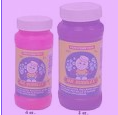pHzero
Hazard to Self
 
Posts: 89
Registered: 16-5-2009
Member Is Offline
Mood: Fully substituted
|
|
Gas Leak Detection Spray
If you scroll down on this page, they heave "gas leak detection spray":
http://www.calortoolbox.co.uk/acatalog/accessories.html
Does anyone know whats in it? My guess would be that it's a solution of SO2 in water, which reacts with the ethanethiol additive analogously to the
desulfuration of diesel and suchlike:
2EtSH+SO2 ---> 3S + 2EtOH
Which is analagous to:
2H2S+SO2 ---> 3S + 2H2O
So you'd get an opaque cloud of sulfur dust. Anyone have any information/any other ideas? I cant think of anything which would visibly react with the
propane/butane itself, so some reaction with the EtSH seems like the best explaination.
Are these things even useful though? Ethanethiols pretty smelly stuff. Is it probably designed for anosmics (if thats the right word)?
|
|
|
UnintentionalChaos
International Hazard
    
Posts: 1454
Registered: 9-12-2006
Location: Mars
Member Is Offline
Mood: Nucleophilic
|
|
There's not really any appreciable amount (despite the smell) of the thiols in gas. More likely, it is a viscous noncorossive liquid that is meant to
form bubbles. I've used something similar to this in a lab before.
Department of Redundancy Department - Now with paperwork!
'In organic synthesis, we call decomposition products "crap", however this is not a IUPAC approved nomenclature.' -Nicodem
|
|
|
pHzero
Hazard to Self
 
Posts: 89
Registered: 16-5-2009
Member Is Offline
Mood: Fully substituted
|
|
Quote: Originally posted by UnintentionalChaos  | | There's not really any appreciable amount (despite the smell) of the thiols in gas. More likely, it is a viscous noncorossive liquid that is meant to
form bubbles. I've used something similar to this in a lab before. |
Oh right, that's a bit boring  You could use glycerol to do that, and you can
usually get it for free if you know biodiesel makers You could use glycerol to do that, and you can
usually get it for free if you know biodiesel makers
I know the gas doesnt contain much EtSH, but I thought it might still be enough to form a visible sulfur cloud
|
|
|
GoatRider
Harmless

Posts: 21
Registered: 3-11-2008
Location: Minnesota
Member Is Offline
Mood: No Mood
|
|
The guy who installed my dryer used something like that, it was something soapy that would bubble with gas leaks, but also was non-corrosive so you
wouldn't have to clean it up.
|
|
|
DJF90
International Hazard
    
Posts: 2266
Registered: 15-12-2007
Location: At the bench
Member Is Offline
Mood: No Mood
|
|
I think you'll find ethanethiol present in gas supplies only at a concentration in the parts per million range, if not the parts per billion. Seeing
any visible precipitate of sulfur is incrediably unlikely (work out how many moles/grams it is and you'll see why). General washing up liquid (Fairy
or the likes) will suffice to form bubbles at a gas leak.
|
|
|
IrC
International Hazard
    
Posts: 2710
Registered: 7-3-2005
Location: Eureka
Member Is Offline
Mood: Discovering
|
|
Quote: Originally posted by GoatRider  | | The guy who installed my dryer used something like that, it was something soapy that would bubble with gas leaks, but also was non-corrosive so you
wouldn't have to clean it up. |
This is a decades old trick appliance repair people use which is merely dish-washing liquid such as Ivory and water mixed.
|
|
|
Mr. Wizard
International Hazard
    
Posts: 1042
Registered: 30-3-2003
Member Is Offline
Mood: No Mood
|
|
Use the solution they sell to children to make bubbles. I use 'Mr. Bubbles'
I've been using the same bottle for about 10 years now, and it's getting a little discolored, but it still works. I use a little paint brush or
disposable 'acid brush' to put it on the test areas. It's very sensitive to leaks. If you use a sprayer you are more likely to get a lot of bubbles,
but a brush puts more liquid on the point of interest, with fewer misleading bubbles.

[Edited on 27-6-2009 by Mr. Wizard]
|
|
|